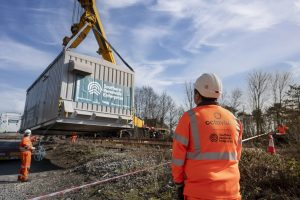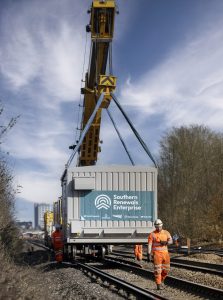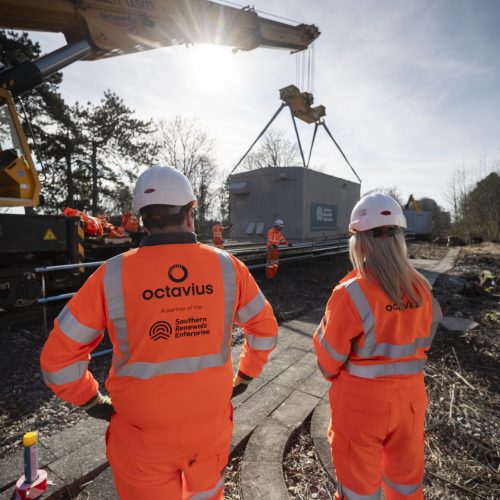Enterprise delivery, using Project 13 principles, is gaining traction. Richard Jackson, E&P Pre-Delivery Lead, Octavius, and Paige Baker, Development Manager, Octavius, examine the delivery model’s influence on rail renewals electrification
Enterprise delivery, embedding Project 13 principles, is becoming an engine of change in the rail infrastructure sector.
Project 13 seeks to remove traditional segmented client, consultant, contractor relationships and reform those parties into a single collaborative enterprise to deliver the asset owner’s – or Capable Owner’s – outcomes. Project 13 has been championed by, among others, the Institution of Civil Engineers and National Infrastructure Commission.
The traditional model can be a barrier to efficient delivery, innovation and the sharing of best practice. Project 13’s enterprise model brings stakeholders together, establishing long-term relationships that encourage the sharing of knowledge, best practice, and experience.
Collectively the enterprise’s constituent companies are better able to innovate, saving time, cost and waste. The aim is to create trusted business-to-business relationships focussed on win:win outcomes.
UK rail enterprise delivery
The Southern Renewals Enterprise (SRE), responsible for renewals across Capable Owner Network Rail’s Southern Region, is the first UK use of the Project 13 model to undertake railway renewals.
Central to the SRE is Southern Integrated Delivery (SID) which is responsible for the planning, specification, assembly and hand back of the full renewals portfolio. The SID partners are coordinating and delivering five interlinked disciplines:
- Electrification and plant – Octavius
- Building and civils – VolkerFitzpatrick
- Signalling – AtkinsRéalis
- Track – VolkerRail
- Minor works – Network Rail

Because of the nature of the enterprise model, all partners have visibility of the entire CP7 renewals programme, meaning the Electrification and plant (E&P) team were aware of all of the projects they would need to deliver during the control period; and could see that the switchgear and NSCD programmes were due to be undertaken in separate years – with the former falling under the renewals funding stream, the latter under the Electrical Safety Delivery funding stream.
Knowing that there were synergies between the DC switchgear and NSCD programmes the team chose to unify the work into a single programme.
Removing duplication
The original schedule required separate projects, at different times, on the same sites. Combining the two programmes removed the need to work on the same sites more than once. This created efficiency savings by avoiding duplication of activities. Further efficiencies were achieved by specifying a single, modular device which combined both switchgear renewal and NSCD installation functions.
Using a single piece of equipment able to perform both functions allowed a more standardised design, and reduced civils and mechanical and electrical engineering costs. There were also operational advantages for the Capable Owner as only one piece of equipment needs to be maintained.
Having previously trialled the combined equipment, the E&P team had confidence in its performance and familiarity with its installation. The integrated equipment was specified for three sites of an eight-site renewals programme. The first project using the combined equipment was at Winklebury in Hampshire.
Engaging end users
The E&P team’s approach maximised the benefits of enterprise delivery. Some of the tactics were not exclusive to an enterprise delivery environment, but many were more effective as a result of it.
A workshop structure was used for the optioneering sessions. Involving the Routes in optioneering – including maintenance and operations teams – meant end users participated in decision making from the outset. This allowed aspects of the design that presented delivery and operational challenges to be addressed early in the project.
Although renewals are in essence like-for-like replacements, they offer some scope for improving upon the asset being replaced. Thus, the E&P team’s approach to optioneering offered a way to stop re-introducing problems present in the previous design. Often these problems were site-specific.
Digital twinning
Matterport is a subscription-based 3D data platform that generates 360° scans like those used on Google Street View. The tool enables users to create an accurate digital twin of the space they have scanned. Its application for the programme was proposed by Octavius’ technology team.

Matterport allowed the team to create digital models during their initial site visits. The models provided an extra data set and expanded the information available to stakeholders during optioneering. Although older photographic records were available, they tended to show the switchgear but not its surrounding environment.
The 3D scans allowed the extended group of disciplines involved in optioneering to see and comment on aspects of the existing assets and proposals to renew them. This allowed stakeholders to better understand the planned renewal work and provide more informed input.
Outline electrical design was undertaken by Octavius’ subsidiary, electrical engineering consultancy Navitas. Because the designers were supporting the entire switchgear/NSCD programme from the beginning they were able to rationalise the design, packaging design deliverables for multiple sites into a single submission, with eight site-specific appendices. This reduced design costs and negated the need to review the same design multiple times.
While this approach is not exclusive to enterprise delivery, its effectiveness in the SRE setting was notably enhanced by strong stakeholder engagement. For example, early feedback from site engineers led to refinements in the digital models that improved design accuracy. Compared to traditional contracting models, where stakeholder input can be limited or delayed, the SRE framework fostered a more collaborative environment – contributing to faster decision-making and reduced design rework.
Having visibility of all of the projects planned for the control period also enhanced optioneering. Having this information made design and planning more efficient because it was possible to bundle work in the most logistically productive way.
All this was achieved during a formative period for the SRE. As one of the earlier CP7 projects, it was first developed while the SRE was still in its mobilisation phase – meaning that SRE processes, roles, and expectations were still being defined. This added a layer of complexity, but also created space for innovation and flexibility in how the programme was shaped and delivered, which went on to become an example of best practice in terms of how the wider SRE comes together to work collaboratively to develop efficient solutions.
Delivery focussed design
Electrification and plant detailed design was also undertaken by Navitas. The aim was to maximise the benefits of using modular combined switchgear and NSCD equipment. Units were delivered to multiple locations during weekend possessions, making efficient use of the limited availability of Track Partner VolkerRail’s Kirow Crane.
For Winklebury Octavius’ team chose a ‘self delivery’ approach for the electrical installation. A labour supplier provided the workforce, which the E&P team managed directly. Using their own site managers and assurance supervisors meant the E&P team was better able to manage risk and achieve cost savings. Although this approach suited Winklebury it will not necessarily be applicable to other projects.
Unusually, the Design Manager was involved throughout the project. Doing this means the efficiencies and cost savings achieved during Winklebury’s design phase will be incorporated into the programme’s other projects; as will lessons learnt during Winklebury’s delivery. The potential to repeat mistakes is reduced with delivery and buildability incorporated into future designs.
Winklebury went into service in May 2025. The project was completed ahead of schedule, with stakeholders providing positive feedback about the quality of the physical asset created; enhancing their confidence in the way the project was delivered and the outcome of the remainder of the combined switchgear renewal and NSCD installation programme.
With the enterprise delivery/Project 13 approach likely to become more widely adopted for rail infrastructure delivery, the SRE E&P team’s learnings will prove a valuable resource for other disciplines within SRE and the wider Octavius rail business.
This article was originally published in Rail Director, August 2025; republished with thanks to Rail Business Daily.

